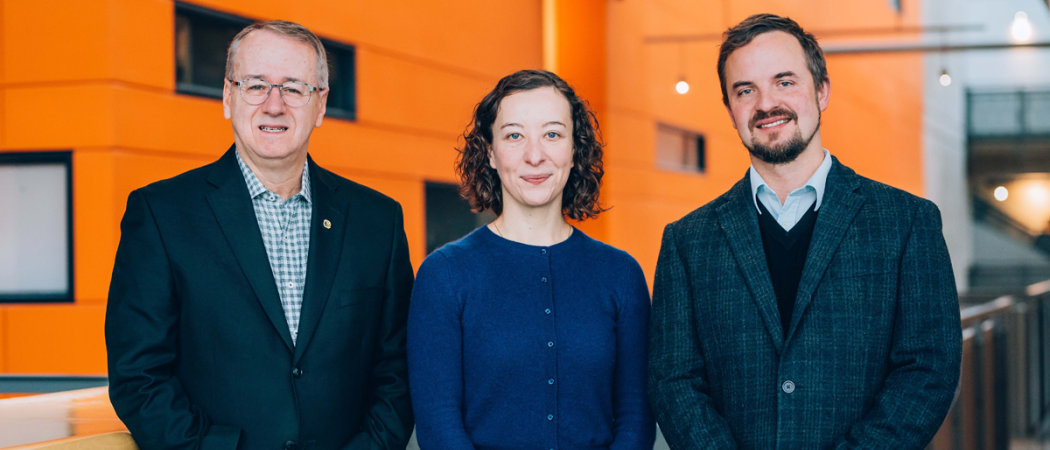
From left to right: Stéphane Kéna-Cohen, Assistant Professor, Department of Engineering Physics, Polytechnique Montréal; Oussama Moutanabbir, Associate Professor, Department of Engineering Physics, Polytechnique Montréal.
More than $2.1 million will be spent over three years on three engineering physics research projects led by professors Stéphane Kéna-Cohen and Oussama Moutanabbir of Polytechnique Montréal.
The Honourable Kirsty Duncan, Minister of Science and Sport for the Government of Canada, announced funding of over $78 million to recipients of Strategic Partnership Grants for Networks and Projects, supported by the Natural Sciences and Engineering Research Council of Canada (NSERC). In particular, just over $45 million will be spent on 80 projects across Canada involving university, private and public research units.
Three research projects by two professors at Polytechnique Montréal received grants totalling $2,134,121 through the Strategic Partnership Grant for Projects program:
Towards tunable and scalable black phosphorus photodetectors
Holder: Stéphane Kéna-Cohen, Assistant Professor, Department of Engineering Physics, Polytechnique Montréal
Professor Kéna-Cohen’s research project focuses on the development of infrared photodetectors based on black phosphorus, a stable phosphorus allotrope that has a lamellar structure that can be exfoliated to the monolayer, much like graphene. This two-dimensional semiconductor is distinguished by its high electronic mobilities, an anisotropic band structure and a direct forbidden band that absorbs light efficiently. In addition, the absorption of black phosphorus is adjustable from the mid-infrared to the visible infrared, via the thickness of the sample, and dynamically under the effect of an electric field. These properties are unique among two-dimensional (2D) and bulk semiconductors.
The objective of the research project is to develop low-cost black phosphorus photodetectors, with improved efficiency and operating speeds in the infrared region of the spectrum, in partnership with Excelitas Technologies Corp. Such photodetectors will have potential applications in telecommunications, spectroscopy, telemetry and thermal imaging.
Monolithic multi-junction III-V solar cells with optimal 1 eV subcell
Holder: Osama Moutanabbir, Associate Professor, Department of Engineering Physics, Polytechnique Montréal
This research project led by Professor Moutanabbir aims to design, develop and optimize new monolithic multi-junction III-V solar cells that will include an optimal 1 eV forbidden band subcell.
The concept put forward in the project involves the use of junctions composed of indium gallium phosphide, gallium arsenide phosphide, silicon-germanium-tin and germanium on silicon. The adjustment capacity around 1 eV of the subcell band structure will allow for optimal absorption of the solar spectrum.
This approach will push the efficiency of multi-junction photovoltaic cells toward the thermodynamic limit while integrating them on robust and inexpensive platforms. The success of this project would expand the use of III-V technology beyond space applications and meet the growing need for renewable energy.
Scalable Group V two-dimensional materials for mid-infrared optoelectronics
Holder: Oussama Moutanabbir, Associate Professor, Department of Engineering Physics, Polytechnique Montréal
This research project under the direction of Professor Moutanabbir involves 2D materials, an emerging class of quantum materials that are obtained using controlled growth processes at the atomic level. Two-dimensional materials in this class have superior physical properties capable of revolutionizing the development of future applications in nanoelectronics, photonics, quantum information and clean energy. The project focuses on the development of a new family of Group V 2D mono-elemental materials: Van der Waals heterostructures based on antimonene (or 2D antimony) and arsenene (or 2D arsenic).
Theoretical predictions show that these new Group V materials are very stable, while they have two-dimensional quantum confinement properties similar to those of graphene, and a band structure that can be adjusted to manipulate the electromagnetic spectrum from blue to mid-infrared. These features will help circumvent the fundamental limitations of current 2D materials that hinder their use in technological applications, namely the absence of a semiconductor band structure, instability and degradation under ambient conditions as well as the lack of a large-scale synthesis process.
“I commend today’s recipients for the important work they are doing to contribute to Canada’s competitiveness,” Ms. Duncan said at an event in Oakville, Ontario. “We are investing in you today because we know that when we invest in science and research we are investing in Canadians. The bold ideas your innovative partnerships will generate will have an important impact on our economy, creating good jobs and unique training opportunities for scientists and engineers [in Canada].”
Learn more
Expertise profile of Professor Stéphane Kéna-Cohen
Expertise profile of Professor Oussama Moutanabbir
Website of the Polytechnique Montréal Engineering Physics Department
List of recipients of the NSERC Strategic Partnership Grants for Projects following the 2017 competition



 A unique international forum for public research organisations and companies to connect their external engagement with strategic interests around their R&D system.
A unique international forum for public research organisations and companies to connect their external engagement with strategic interests around their R&D system.